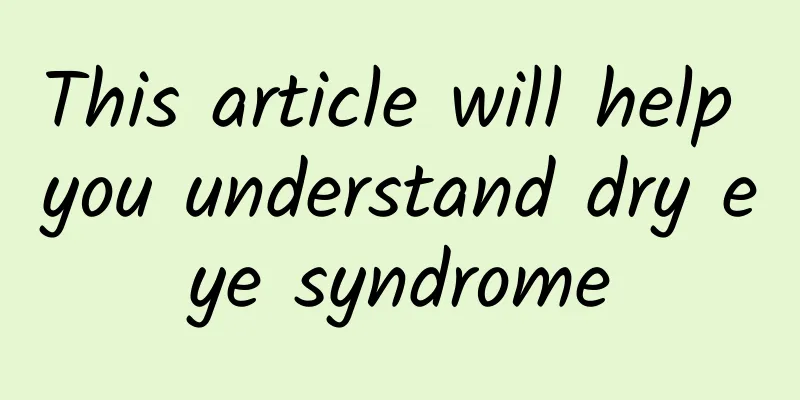This article will help you understand dry eye syndrome

|
1. What is dry eye syndrome? Dry eye syndrome is a common ophthalmic disease, also known as corneal and conjunctival dryness, which is common in middle-aged and elderly people. As the application rate of electronic devices in society gradually increases, the incidence of dry eye syndrome in young people is also gradually increasing, and prevention and control work is in an imminent state. Dry eye syndrome occurs when the glands that secrete tears in the eyes degenerate and atrophy due to specific reasons. Patients may feel dryness and burning in their eyes, and their vision often becomes blurred. They may be accompanied by a foreign body sensation and itching, which has a relatively obvious adverse effect on the quality of life. The picture comes from the Internet 2. Why does dry eye syndrome occur? The causes of dry eyes are relatively complex and may be related to four factors. The first is that the tear secretion of the aqueous layer tear gland is too low, which is one of the most common causes of dry eyes. The causes of insufficient tear secretion may be related to age, trauma, accidental infection, autonomic nervous system disorders, and in some cases, it may also be related to long-term use of hormone eye drops and wearing contact lenses for too long. The second factor is insufficient oil secretion, which may be related to some eyelid diseases, such as meibomian gland hypofunction. The third factor is insufficient mucin secretion, which is mainly related to conjunctivitis, vitamin A deficiency, and chemical burns of the eyes. The fourth factor is too fast tear evaporation and uneven distribution of tear film, which may be related to poor eyelid closure, too few blinks, and long-term stay in air-conditioned rooms. In addition, dry eyes can be divided into five different basic types, namely lipid deficiency, aqueous deficiency, water-oil deficiency, mucin deficiency, and abnormal tear dynamics. Among them, lipid deficiency is one of the most common types of dry eye. If not treated in time, it may lead to further development, which is not conducive to improving the prognosis. The picture comes from the Internet 3. What is the common diagnosis method for dry eye syndrome? Dry eye diagnosis can be done in a variety of ways, such as tear secretion tests. Tear secretion tests need to be conducted under dim light conditions. The diagnosis can be completed by placing the test paper into the conjunctival sac under the eyeball and keeping the eyes looking down or closed. The test paper needs to be taken out after 5 minutes to observe the length of the paper soaked in tears. If the length is greater than 30mm, it proves that the tear secretion of the eye is normal. If it is less than 5mm, it proves that dry eye is present. The picture comes from the Internet Tear film breakup time is also one of the main diagnostic methods for dry eye. It requires using a test paper with fluorescein to gently touch the conjunctival sac and using a slit lamp to observe the surface of the cornea. The time is counted from the last blink until the fluorescein film on the corneal surface is observed to break. The timing result is the tear film breakup time, which should be at least greater than 10 seconds. If the time is less than 10 seconds, it proves that the tear film is unstable and it is dry eye. The tear film osmolarity test is a professional method for diagnosing dry eyes. The tear film osmolarity of patients with dry eyes is higher than that of the general population, and can reach up to 312mOsm/L or more. If the measured osmotic pressure is greater than this standard, it proves that the individual suffers from dry eyes. The tear lysozyme content is similar to this test, and the average value of the general population is 1700ug/ml. If the individual value is less than 1200ug/ml, it proves that the individual suffers from dry eyes. In addition to the above tests, the diagnosis of dry eyes can also be carried out by tear meniscus curvature radius detection, corneal topography examination and other methods. These examinations should be performed under professional conditions and should not be performed at home to prevent accidents. 4. How to treat dry eyes? Treatment of dry eye needs to be symptomatic. If the problem is related to the use of hormone drugs or long-term wearing of contact lenses, the drugs or contact lenses should be discontinued in time to avoid damage to the tear gland function. If dry eye is caused by systemic diseases, a general consultation is required, and dry eye treatment is carried out on the basis of treating the primary disease. If the problem is related to the external environment, such as working in an air-conditioned room for a long time, frequently using electronic devices, etc., it is necessary to change the external influencing conditions, such as moving to a normal room to work, reducing the time of using electronic devices, etc., and pay attention to increasing the rest time of the eyes to avoid further aggravation of dry eye. For the problem of excessive tear evaporation, it can be treated by wearing a silicone eye mask. Some patients with meibomian gland dysfunction need to be treated with physical therapy. Conventional treatment methods also include tear duct embolism, wearing a wet chamber mirror, psychological intervention and other measures. Treatment should be carried out in combination with the actual situation of the patient to ensure that the ideal non-drug treatment effect can be obtained. In addition to conventional treatments, nutritional support is also needed. Patients should increase their water intake, maintaining more than 1500 mL per day, and appropriately supplement nutrients such as vitamin A and fatty acids. It should be noted that vitamin A is a fat-soluble vitamin and should not be supplemented for a long time or in excess to prevent poisoning. In addition to nutritional support, patients should go to the ophthalmology clinic for regular follow-up examinations. If the dryness of the eyes worsens, you need to seek medical attention and professional advice in time to avoid worsening of dry eyes. The picture comes from the Internet Drug treatment is one of the common treatment options for dry eye. For common dry eye, patients can use artificial tears as eye drops and use them appropriately in daily life to relieve dry eye. For patients with insufficient tear secretion, drugs such as brombenzylcyclohexyl can be taken orally to ensure that the amount of tear secretion can be increased. Dry eye in some patients is related to eye inflammation. Cyclosporine A eye drops can be used for treatment to reduce eye inflammation and increase the total amount of tear secretion. For eye inflammation problems, local anti-inflammatory or immunosuppressant drugs can also be used for treatment. Autologous serum is also one of the cutting-edge treatment options. Appropriate intervention strategies should be selected based on the actual situation of the patient. In addition, physical therapy is also a common treatment option. By integrating massage, atomization, hot compress, cold compress and other measures, the patient's meibomian glands can be effectively dredged and the surface tears can be locked to achieve ideal treatment effects. Before starting physical therapy, patients should actively communicate with their doctors to understand the main types of dry eye and analyze whether there are other direct treatment options. Deep eyelid margin cleaning is one of the common physical therapy options. It requires the use of a disposable medical brush head to clean the eyelid margin to remove scales, lipid secretions and microorganisms, which is beneficial for treating patients with dry eye with corneal conjunctivitis or meibomian gland dysfunction. In addition, intense pulsed light (IPL) and thermal pulsation (Lipiflow) are also excellent treatment options for dry eye. These two treatment measures can effectively change the properties of meibomian gland secretions by heating and dissolving meibum, thereby achieving the ideal intervention effect. By choosing a treatment measure that suits you, you can effectively improve the treatment effect of dry eye and provide strong support for relieving eye discomfort symptoms. The picture comes from the Internet For patients with significantly reduced tear secretion and poor response to the above treatments, who may suffer from visual impairment, surgical treatment should be chosen. Surgical treatments include tarsal suture, submandibular gland transplantation, lip gland transplantation, etc. Appropriate surgical treatment measures should be selected based on the actual needs of the patient and the prognosis. |
<<: Home Guidelines for People Infected with COVID-19 (First Edition)
>>: Water is both the source of life and an obstacle to the formation of life. Why do we say that?
Recommend
How much does it cost to customize a cosmetics mini app in Wuhan?
The main factors affecting the price of mini prog...
Without eating feed, can beef “raised” in a test tube be delicious?
Nowadays, many people love to eat beef, because b...
How to get an invoice for Tencent advertising recharge? Invoice application guide!
How to apply for an invoice 1.How to get the invo...
New App Promotion Techniques: Video Promotion Makes Your App Popular Overnight
Everyone on the Internet is familiar with Chai Ji...
Teach you how to sell courses on Douyin, monetize your knowledge, and enter the million-dollar club (worth 699 yuan)
Teach you how to sell courses on Douyin, monetize...
86 years old, millions of fans! A conversation with Academician Wang Pinxian: Why are scientists afraid to become famous?
Author | Li Chenyang After the Tonga volcano erup...
China Passenger Car Association: China's automobile exports will reach 4.76 million units from January to November 2023, and the growth rate will still maintain a high growth rate of over 50%
Cui Dongshu, secretary general of the China Passe...
Android N debuts at Google I/O, name still undecided
In the early morning of May 19th, the annual Goog...
How to do data analysis well? There are 5 key links!
In the era of big data and mobile Internet , ever...
A complete template for advertising planning!
Today I will share with you how to plan the place...
4 tips and 6 taboos for live streaming sales
As a short video platform with more than 600 mill...
2019 Fliggy 3rd Anniversary Event Planning and Promotion Plan!
This article mainly wants to share with you my pe...
How much does it cost to attract investment in the Haikou children’s clothing mini program? What is the investment quotation for the Haikou children's clothing mini program?
How much does it cost to invest in the Haikou chi...
Super useful information! To do community fission, just read this article
Everyone may be familiar with social fission . Co...
The turtle tested positive for cholera! Can we still eat and drink it safely? !
On the evening of July 9 this year, the Wuchang D...









